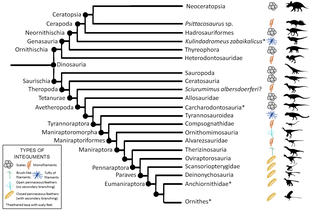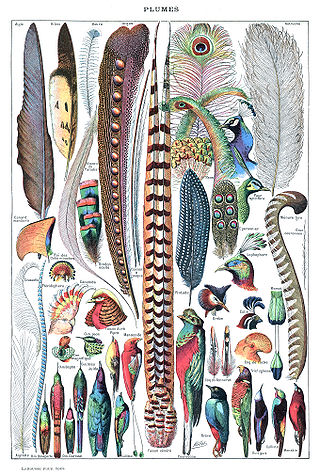
Feathers are epidermal growths that form a distinctive outer covering, or plumage, on both avian (bird) and some non-avian dinosaurs and other archosaurs. They are the most complex integumentary structures found in vertebrates and an example of a complex evolutionary novelty. They are among the characteristics that distinguish the extant birds from other living groups.

Theropoda (; from ancient Greek θηρίο-ποδός [θηρίον, "wild beast"; πούς, ποδός "foot"] whose members are known as theropods, is a dinosaur clade that is characterized by hollow bones and three toes and claws on each limb. Theropods are generally classed as a group of saurischian dinosaurs. They were ancestrally carnivorous, although a number of theropod groups evolved to become herbivores and omnivores. Theropods first appeared during the Carnian age of the late Triassic period 231.4 million years ago and included the majority of large terrestrial carnivores from the Early Jurassic until at least the close of the Cretaceous, about 66 Ma. In the Jurassic, birds evolved from small specialized coelurosaurian theropods, and are today represented by about 11,000 living species.

Archosauria or archosaurs is a clade of diapsid sauropsid tetrapods, with birds and crocodilians being the only extant representatives. Although broadly classified as reptiles, which traditionally exclude birds, the cladistic sense of the term includes all living and extinct relatives of birds and crocodilians such as non-avian dinosaurs, pterosaurs, phytosaurs, aetosaurs and rauisuchians as well as many Mesozoic marine reptiles. Modern paleontologists define Archosauria as a crown group that includes the most recent common ancestor of living birds and crocodilians, and all of its descendants.

Maniraptora is a clade of coelurosaurian dinosaurs which includes the birds and the non-avian dinosaurs that were more closely related to them than to Ornithomimus velox. It contains the major subgroups Avialae, Dromaeosauridae, Troodontidae, Oviraptorosauria, and Therizinosauria. Ornitholestes and the Alvarezsauroidea are also often included. Together with the next closest sister group, the Ornithomimosauria, Maniraptora comprises the more inclusive clade Maniraptoriformes. Maniraptorans first appear in the fossil record during the Jurassic Period, and survive today as living birds.
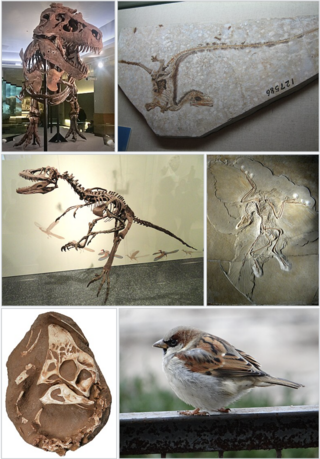
Coelurosauria is the clade containing all theropod dinosaurs more closely related to birds than to carnosaurs.

A feathered dinosaur is any species of dinosaur possessing feathers. That includes all species of birds, and in recent decades evidence has accumulated that many non-avian dinosaur species also possessed feathers in some shape or form. The extent to which feathers or feather-like structures were present in dinosaurs as a whole is a subject of ongoing debate and research.

Archosauriformes is a clade of diapsid reptiles encompassing archosaurs and some of their close relatives. It was defined by Jacques Gauthier (1994) as the clade stemming from the last common ancestor of Proterosuchidae and Archosauria. Phil Senter (2005) defined it as the most exclusive clade containing Proterosuchus and Archosauria. Archosauriforms are a branch of archosauromorphs which originated in the Late Permian and persist to the present day as the two surviving archosaur groups: crocodilians and birds.

Scansoriopterygidae is an extinct family of climbing and gliding maniraptoran dinosaurs. Scansoriopterygids are known from five well-preserved fossils, representing four species, unearthed in the Tiaojishan Formation fossil beds of Liaoning and Hebei, China.

Dinosauromorpha is a clade of avemetatarsalians that includes the Dinosauria (dinosaurs) and some of their close relatives. It was originally defined to include dinosauriforms and lagerpetids, with later formulations specifically excluding pterosaurs from the group. Birds are the only dinosauromorphs which survive to the present day.

Anurognathidae is a family of small, short-tailed pterosaurs that lived in Europe, Asia, and possibly North America during the Jurassic and Cretaceous periods. Five genera are known: Anurognathus, from the Late Jurassic of Germany; Jeholopterus, from the Middle to Late Jurassic of China; Dendrorhynchoides, from the Middle Jurassic of China; Batrachognathus, from the Late Jurassic of Kazakhstan; and Vesperopterylus, from the Early Cretaceous of China. Bennett (2007) suggested that the holotype of Mesadactylus, BYU 2024, a synsacrum, belonged to an anurognathid, though this affinity has been questioned by other authors. Mesadactylus is from the Late Jurassic Morrison Formation of the United States. Indeterminate anurognathid remains have also been reported from the Middle Jurassic Bakhar Svita of Mongolia and the Early Cretaceous of North Korea.

Avemetatarsalia is a clade of diapsid reptiles containing all archosaurs more closely related to birds than to crocodilians. The two most successful groups of avemetatarsalians were the dinosaurs and pterosaurs. Dinosaurs were the largest terrestrial animals for much of the Mesozoic Era, and one group of small feathered dinosaurs has survived up to the present day. Pterosaurs were the first flying vertebrates and persisted through the Mesozoic before dying out at the Cretaceous-Paleogene (K-Pg) extinction event. Both dinosaurs and pterosaurs appeared in the Triassic Period, shortly after avemetatarsalians as a whole. The name Avemetatarsalia was first established by British palaeontologist Michael Benton in 1999. An alternate name is Pan-Aves, or "all birds", in reference to its definition containing all animals, living or extinct, which are more closely related to birds than to crocodilians.

The scientific question of within which larger group of animals birds evolved has traditionally been called the "origin of birds". The present scientific consensus is that birds are a group of maniraptoran theropod dinosaurs that originated during the Mesozoic Era.

Compsognathidae is a family of coelurosaurian theropod dinosaurs. Compsognathids were small carnivores, generally conservative in form, hailing from the Jurassic and Cretaceous Periods. The bird-like features of these species, along with other dinosaurs such as Archaeopteryx inspired the idea for the connection between dinosaur reptiles and modern-day avian species. Compsognathid fossils preserve diverse integument — skin impressions are known from four genera commonly placed in the group, Compsognathus, Sinosauropteryx, Sinocalliopteryx, and Juravenator. While the latter three show evidence of a covering of some of the earliest primitive feathers over much of the body, Juravenator and Compsognathus also show evidence of scales on the tail or hind legs. "Ubirajara jubatus", informally described in 2020, had elaborate integumentary structures on its back and shoulders superficially similar to the display feathers of a standardwing bird-of-paradise, and unlike any other non-avian dinosaur currently described.

Avialae is a clade containing the only living dinosaurs, the birds, and their closest relatives. It is usually defined as all theropod dinosaurs more closely related to birds (Aves) than to deinonychosaurs, though alternative definitions are occasionally used.

Ornithurae is a natural group which includes the common ancestor of Ichthyornis, Hesperornis, and all modern birds as well as all other descendants of that common ancestor.
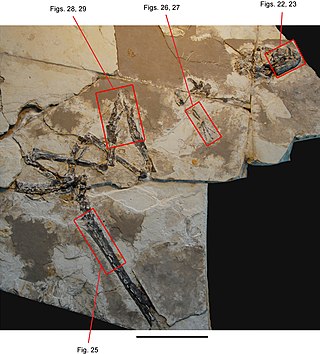
Tianyulong is an extinct genus of heterodontosaurid ornithischian dinosaur. The only species is T. confuciusi, whose remains were discovered in Jianchang County, Western Liaoning Province, China.

Sciurumimus is an extinct genus of tetanuran theropod from the Late Jurassic Torleite Formation of Germany. It is known from a single juvenile specimen representing the type species, Sciurumimus albersdoerferi, which was found in a limestone quarry close to Painten in Lower Bavaria. The specimen was preserved with traces of feather-like filaments.
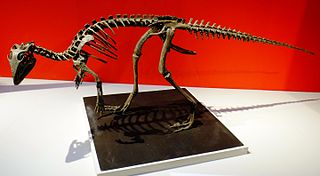
Kulindadromeus was a herbivorous dinosaur, a basal neornithischian from the Middle Jurassic. The first Kulindadromeus fossil was found in Russia. Its feather-like integument is evidence for protofeathers being basal to Ornithischia and possibly Dinosauria as a whole, rather than just to Coelurosauria, as previously suspected.
Cascocauda is an extinct genus of anurognathid pterosaur from the Late–Middle Jurassic Tiaojishan Formation of Hebei Province, China. The genus contains a single species, C. rong, known from a complete skeleton belonging to a juvenile individual preserved with extensive soft-tissues, including wing membranes and a dense covering of pycnofibres. Some of these pycnofibres appear to be branched, resembling the feathers of maniraptoran theropod dinosaurs, and suggesting that pterosaur pycnofibres may be closely related to feathers in dinosaurs.

